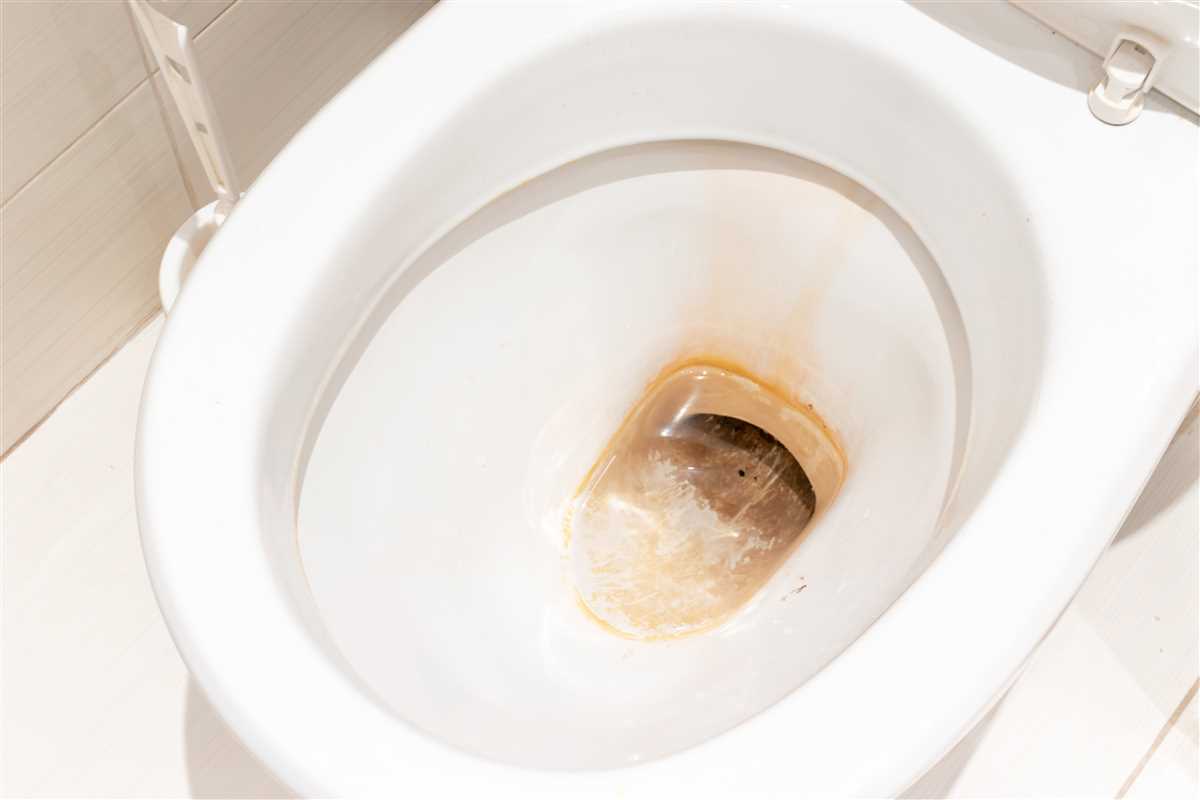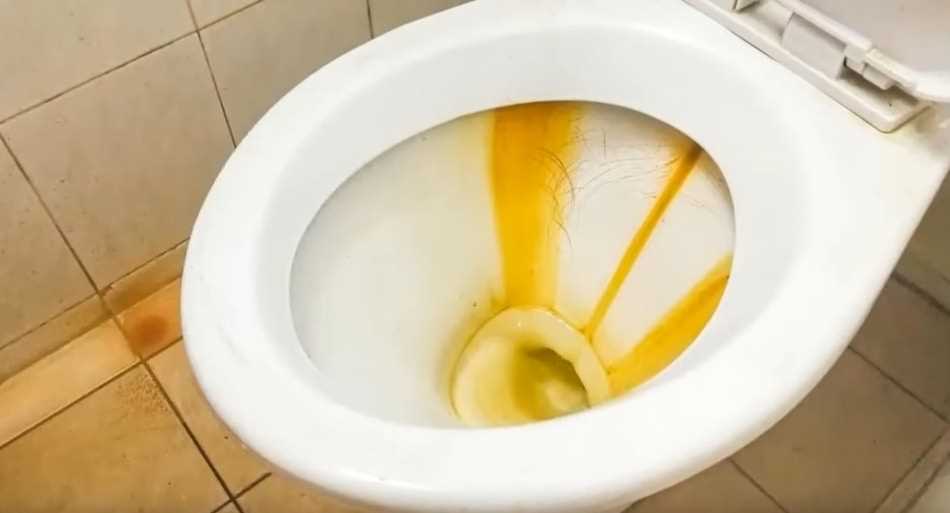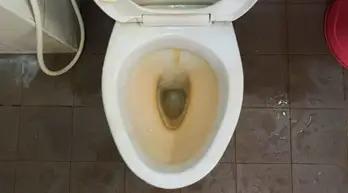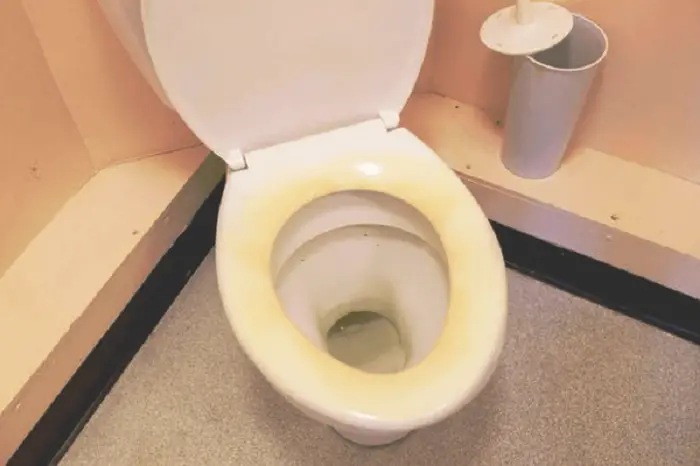




Have you ever noticed yellow stains on your toilet seat and wondered where they come from? It’s a common problem that many people encounter, but the causes of these stains can vary. In this article, we will explore the culprits behind yellow stains on toilet seats and discuss potential solutions.
One possible cause of yellow stains on toilet seats is hard water. Hard water contains high levels of minerals, such as calcium and magnesium, which can leave behind yellowish deposits on surfaces. If your area has hard water, it’s likely that these deposits are responsible for the stains on your toilet seat.
Another culprit behind yellow stains on toilet seats is urine. When urine comes into contact with the surface of a toilet seat, it can leave behind yellow or brownish stains. This is especially common in households with young children or individuals who struggle with aim. Regular cleaning and maintenance can help prevent urine stains from becoming a persistent issue.
Additionally, mold and mildew can also contribute to the development of yellow stains on toilet seats. The moist environment of a bathroom provides the perfect conditions for mold and mildew growth. Over time, these organisms can leave behind yellowish marks that are difficult to remove. Proper ventilation and regular cleaning can help prevent mold and mildew stains.
In conclusion, several factors can contribute to the appearance of yellow stains on toilet seats. Hard water deposits, urine stains, and mold and mildew growth are common culprits. By understanding the causes of these stains, you can take appropriate measures to prevent them or effectively remove them when they occur.
The Role of Minerals
Minerals can play a significant role in the formation of yellow stains on toilet seats. When the water supply contains high levels of minerals such as calcium and magnesium, it can lead to the formation of limescale. Limescale is a hard, chalky deposit that can build up on surfaces over time.
When water containing minerals is left to evaporate on the surface of a toilet seat, the minerals can be left behind, causing the development of yellow stains. This can be particularly common in areas with hard water, which contains high mineral content.
Additionally, minerals can also react with other substances present in the toilet, such as urine or cleaning chemicals, leading to further discoloration. These reactions can result in the formation of yellowish or brownish stains on the toilet seat.
To prevent the build-up of mineral deposits and the development of yellow stains, it is important to regularly clean and maintain the toilet seat. Using cleaning products specifically designed to remove limescale and mineral deposits can help prevent the formation of stains. Additionally, using water softeners or filtration systems can be effective in reducing the mineral content of the water supply.
Understanding How Minerals Can Cause Yellow Stains on Toilet Seats
When you notice yellow stains on your toilet seat, it can be quite frustrating and unsightly. One of the common causes of these stains is the presence of minerals in the water supply.
Minerals in Water
Water naturally contains various minerals, such as iron, manganese, and calcium. These minerals can find their way into the toilet bowl and seat through the water supply. If the water in your area has a high mineral content, it can lead to the formation of yellow stains over time.
Hard Water

Hard water, which contains high levels of minerals, is a common problem in many households. When hard water evaporates on the toilet seat surface, it leaves behind mineral deposits, causing yellow stains. The stains can be particularly visible if the toilet seat has a glossy or smooth surface.
Mineral Buildup
Over time, continuous exposure to minerals in the water can result in a buildup of deposits on the toilet seat. The minerals react with the porcelain or plastic surface, leading to the formation of stubborn yellow stains that can be difficult to remove.
Preventing Mineral Stains

To prevent or minimize the occurrence of yellow stains on the toilet seat due to minerals in the water, you can take a few steps:
- Install a water softener: A water softener can help remove excess minerals from the water supply, reducing the chances of stains.
- Regular cleaning: Regularly clean and remove mineral deposits from the toilet seat using appropriate cleaning products.
- Use vinegar or lemon juice: These natural acidic substances can help break down mineral buildup and remove yellow stains.
- Wipe dry: After every use, wipe the toilet seat dry to prevent water and mineral buildup.
Conclusion
Yellow stains on the toilet seat can be caused by minerals present in the water supply. Hard water and continuous exposure to minerals can lead to the formation of stubborn yellow stains. By understanding the role of minerals in these stains and taking preventative measures, you can keep your toilet seat cleaner and free from unsightly stains.
The Impact of Hard Water
Hard water is a common culprit of yellow stains on toilet seats. This type of water contains high levels of dissolved minerals such as calcium and magnesium. When hard water comes into contact with surfaces like toilet seats, it can leave behind mineral deposits that result in the unsightly yellow stains.
The presence of hard water can have several negative impacts on your toilet seat:
- Stains: As mentioned earlier, hard water stains can leave yellow marks on the surface of toilet seats. These stains can be difficult to remove and may require special cleaning products.
- Build-up: With continuous exposure to hard water, mineral deposits can build up over time, leading to a thick layer of scale on toilet seats. This build-up not only affects the appearance of the seat but can also affect its functionality.
- Deterioration: The minerals in hard water can cause the materials of the toilet seat to deteriorate over time. This can lead to cracks, discoloration, and an overall decrease in its lifespan.
It is important to note that the impact of hard water can vary depending on the severity of the water hardness and the frequency of exposure. Some areas may have harder water than others, leading to more pronounced effects on toilet seats.
To combat the effects of hard water on toilet seats, it is recommended to regularly clean and maintain the seat. Using cleaning products specifically designed to remove mineral deposits can help remove the yellow stains and prevent further build-up.
| Method | Description |
|---|---|
| Vinegar | Soak a cloth or sponge in vinegar and scrub the stained areas. Let it sit for a while before rinsing with water. |
| Baking Soda | Mix baking soda with water to form a paste. Apply the paste to the stains, scrub, and rinse. |
| Lemon Juice | Squeeze lemon juice onto the stains and let it sit for a while. Scrub with a cloth or sponge and rinse. |
| Commercial Cleaners | There are various commercial cleaners available specifically designed to remove hard water stains. Follow the instructions on the product for best results. |
By understanding and addressing the impact of hard water on toilet seats, you can maintain a cleaner and more aesthetically pleasing bathroom environment.
Why Hard Water Can Lead to Yellow Stains on Toilet Seats

Hard water is a common issue that affects many homeowners, and it can lead to various problems, including yellow stains on toilet seats. Understanding how hard water can cause these stains is essential for addressing the issue and preventing further damage.
What is hard water?
Hard water refers to water that contains high levels of minerals, such as calcium and magnesium. These minerals are naturally present in the ground and can dissolve in water as it travels through rocks and soil. When water has a high mineral content, it is classified as hard water.
How does hard water cause yellow stains?

When hard water comes into contact with surfaces, such as toilet seats, the minerals in the water can leave behind residue. Over time, these mineral deposits can build up and form yellow stains. The most common minerals that cause yellow stains are calcium and iron.
Calcium deposits, also known as limescale, are a common issue in areas with hard water. When hard water evaporates on toilet seats, it leaves behind calcium deposits that can appear as yellowish stains. Iron in the water can also oxidize and leave behind yellow or reddish streaks.
Preventing and removing yellow stains caused by hard water
To prevent yellow stains caused by hard water, it is important to address the underlying issue of mineral buildup. Here are a few steps you can take:
- Install a water softener: Water softeners can reduce the mineral content in the water, preventing the formation of stains.
- Regular cleaning: Regularly cleaning the toilet seat with a mild household cleaner or vinegar can help remove mineral buildup and prevent stains from forming.
- Use a toilet bowl cleaner: Using a toilet bowl cleaner with ingredients specifically designed to remove mineral deposits can be effective in removing yellow stains.
It’s important to note that prevention is key in combating yellow stains caused by hard water. Regular maintenance and addressing the issue of hard water can help keep toilet seats clean and stain-free.
Bacteria and Mold Growth
One of the main culprits behind yellow stains on toilet seats is the growth of bacteria and mold. Bacteria and mold thrive in warm and moist environments, making toilets a perfect breeding ground for them.
Bacteria:
Bacteria are single-celled microorganisms that can multiply rapidly. They can be found in various places, including the bathroom. When bacteria come into contact with urine or feces, they can break down the waste and release substances that can cause yellow stains on the toilet seat.
Some common bacterial strains that can contribute to yellow stains include:
- Proteus mirabilis: This bacterium produces an enzyme called urease, which breaks down urea in urine, leading to the formation of ammonia. Ammonia can cause yellow stains on the toilet seat.
- Pseudomonas aeruginosa: This bacterium can produce yellow or green pigments, which can stain the toilet seat.
- Staphylococcus: Certain strains of Staphylococcus can produce yellowish or orange pigments that contribute to staining.
Mold:
Mold is a type of fungus that thrives in damp environments. When there is excess moisture in the bathroom, such as from condensation or leaks, it can encourage mold growth. Mold can appear as yellow or greenish spots on the toilet seat.
Preventing Bacteria and Mold Growth:
To prevent the growth of bacteria and mold on toilet seats, it is important to maintain proper bathroom hygiene and cleanliness:
- Regularly clean the toilet seat and surrounding areas with a disinfectant cleaner.
- Wipe away any standing water or moisture in the bathroom.
- Keep the bathroom well-ventilated to reduce excess humidity.
- Flush the toilet with the lid down to prevent the dispersal of bacteria and mold spores.
By taking these preventive measures, you can minimize the risk of yellow stains caused by bacteria and mold growth on your toilet seat.
Exploring How Bacteria and Mold Can Cause Yellow Stains on Toilet Seats
When you notice yellow stains appearing on your toilet seat, it is likely that bacteria and mold are the culprits. Both bacteria and mold thrive in warm and moist environments, making your bathroom an ideal breeding ground for these organisms.
Bacteria:

- Urease-Producing Bacteria: One common type of bacteria found in toilets is urease-producing bacteria. These bacteria feed on the urea found in urine and produce ammonia as a byproduct. Ammonia can cause yellow stains on the toilet seat.
- E. coli and other Fecal Bacteria: Poor hygiene practices or improper cleaning can lead to the growth of E. coli and other fecal bacteria on toilet seats. These bacteria can produce yellow stains and pose a potential health risk.
Mold:

- Mold Growth: Mold thrives in damp environments, and the bathroom provides an ideal habitat. When moisture builds up on the toilet seat, whether from splashes or inadequate ventilation, mold can start to grow. Mold colonies can produce yellow stains on the surface of the seat.
- Mold Spores: Mold spores are microscopic particles that can easily become airborne. If mold spores settle on a damp toilet seat, they can multiply and develop into visible mold colonies, resulting in yellow stains.
Preventing the growth of bacteria and mold is essential for maintaining a clean and hygienic bathroom environment. Regular cleaning with appropriate disinfectants and proper ventilation can help to inhibit the growth of these organisms and reduce the formation of yellow stains on toilet seats.
Chemical Reactions
When it comes to yellow stains on toilet seats, chemical reactions play a significant role. These reactions involve the interaction of different substances that can lead to discoloration.
Oxidation Reactions

Oxidation reactions are one of the most common causes of yellow stains on toilet seats. When certain chemicals, such as minerals in water, come into contact with oxygen, they undergo oxidation. This chemical reaction can result in the formation of yellowish compounds that stick to the surface of the toilet seat.
Hard Water Stains
Hard water stains are another type of chemical reaction that can cause yellow stains on toilet seats. Hard water contains high levels of minerals, such as calcium and magnesium. When hard water is left to dry on the surface of the toilet seat, these minerals can react with other substances present, such as urine or cleaning products, and form yellowish deposits.
Chemical Cleaning Products
Using certain chemical cleaning products can also contribute to the formation of yellow stains on toilet seats. Some toilet cleaning agents contain chemicals, such as bleach or hydrogen peroxide, which can react with the minerals or substances on the toilet seat surface. These reactions can result in discoloration and the appearance of yellow stains.
Bacteria and Fungi
Bacterial and fungal growth can also lead to yellow stains on toilet seats. These microorganisms produce waste products and byproducts that can interact with the surfaces they colonize, causing discoloration. Additionally, the presence of bacteria and fungi can contribute to the growth of other microorganisms, further exacerbating the staining.
It’s important to note that the exact chemical reactions causing yellow stains on toilet seats may vary depending on the specific circumstances and the composition of the substances involved. Therefore, it’s essential to identify and address the underlying causes to effectively prevent and remove yellow stains.
FAQ
What are the common causes of yellow stains on toilet seats?
One common cause of yellow stains on toilet seats is the accumulation of urine and other bodily fluids over time. Another cause can be the growth of bacteria or mold in the moist environment of the toilet seat. Additionally, certain cleaning products or chemicals can cause yellow stains as well.
How can urine cause yellow stains on toilet seats?
Urine contains urobilin, a pigment that can oxidize and cause yellow or brown discoloration over time. When urine comes into contact with the toilet seat, it can seep into the surface and leave behind stains. Proper and regular cleaning can help prevent this buildup.
Can bacteria and mold cause yellow stains?
Yes, both bacteria and mold can cause yellow stains on toilet seats. These microorganisms thrive in moist environments, and if they are present on the toilet seat, they can leave behind yellow or discolored marks. Regular cleaning and proper ventilation can help prevent their growth.
Do certain cleaning products contribute to yellow stains?
Yes, some cleaning products contain chemicals that may react with the materials used in the toilet seat, causing yellow stains. It is important to read the instructions and labels of cleaning products and choose ones that are safe to use on toilet seats. Using gentle cleaners and avoiding abrasive materials can help prevent yellow stains.














